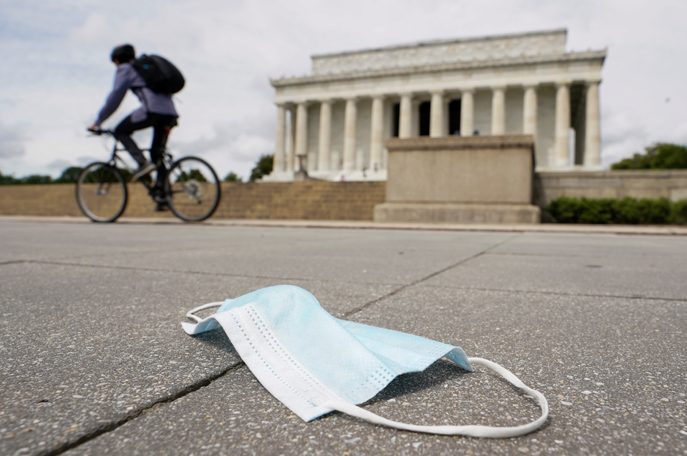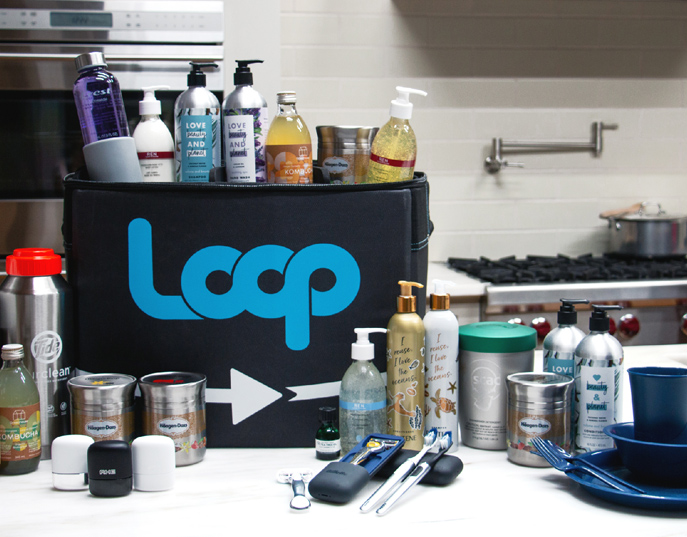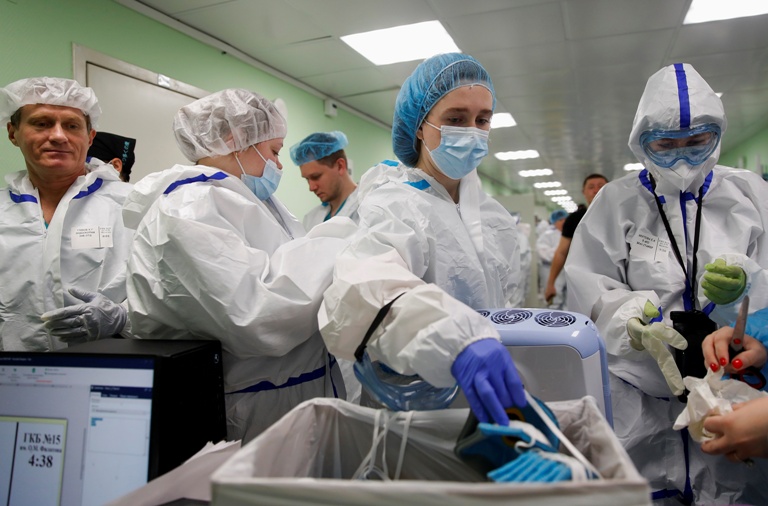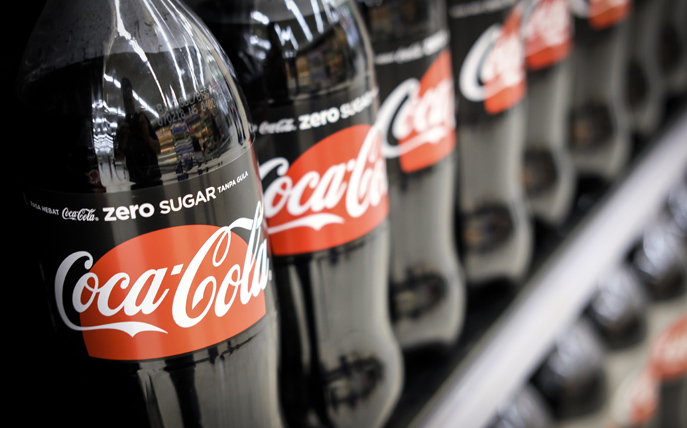With hygiene concerns trumping worries about leakage of plastic waste into the environment, single-use plastic is back with a vengeance. Angeli Mehta assesses the damage, and points to bright spots amid the gloom
In this time of coronavirus, plastics are making a comeback. Concern for hygiene and plummeting oil prices have come together in a perfect storm. There’s been a massive surge in production of face masks, protective suits, aprons, water bottles, visors, take-away food containers, pre-packaged produce, and home deliveries wrapped in single-use plastic bags. And for those deliveries in the UK, the 5p charge brought in to rid us of single-use bags has been waived till the autumn.
The UK government has also pushed back a ban on plastic stirrers, straws and cotton buds for six months; the Scottish government postponed its circular economy bill; and a deposit-return scheme for bottles (including plastic) is delayed until 2022.
A similar scheme in Western Australia, due to be implemented this month, is also postponed. In the midst of these delays, however, Pernod Ricard announced its intention to end single-use plastics at point-of-sale worldwide by next year. Its CEO, Alexandre Ricard, said: “The current crisis must not be a threat but rather an opportunity” to speed up its sustainability initiatives.
Greenpeace US has warned of 'an ecological disaster' if restaurants are encouraged to use disposables when they re-open
In the US, the “bag the ban” campaign is aimed at stopping or overturning bans on plastic bags. Its proponents argue that reusable bags are less safe because they harbour germs, and cite a study suggesting that the virus causing Covid-19 could last as long as three days on polypropylene. Yet that same study suggested infectious virus remained for less time on paper, wood or cloth. It’s not clear why consumers couldn’t simply wash their re-usable bags. Greenpeace US has warned of “an ecological disaster” if restaurants are encouraged to use disposables when they re-open, as has been suggested in the US and Turkey.
McKinsey notes that the hygiene advantages of plastic seem to be outweighing concerns about recyclability, or the leakage of plastic waste into the environment. Wood Mackenzie points out that changes to meat-handling and distribution measures being considered by the Chinese government could increase demand for flexible packaging. However, on the upside, in January China announced it was clamping down on plastics, with plastic bags to be outlawed across towns and cities in 2022.
The European Commission held firm in the face of lobbying by the plastics converters’ trade body, which wanted it to delay its implementation of a single-use plastics ban by at least a year. The Commission said it was critical to press on given the pressure on waste-management systems owing to the pandemic.

But as more purchasing moves online, there is an increasing urgency to find solutions that enable a circular economy. Encouragingly, Loop – a circular shopping platform launched last year by New Jersey recycling firm Terracycle – now has 171 products from 26 brands on its US platform.
What a spokesman described as a “clamour to participate” means the scheme will now be rolled out across the US (except Hawaii and Alaska) this month. In Europe, the French platform, launched with Carrefour, now offers 145 products from 35 brands. A UK-wide roll-out is expected to begin in mid-July, with Tesco integrating Loop into its e-commerce platform at a later date.
Containers from brands including Unilever, Nestlé, and Proctor & Gamble are collected, cleaned and re-used. Three to four uses are required to make the system more sustainable than single-use packaging, but even including the environmental impact of delivery, there’s a claimed 35% reduction in greenhouse gas emissions overall, with each additional reuse bringing further gains.
On the contrary, many of these brands are reaching out to us to say we need to make sure we maintain the momentum on plastics
While record low oil prices make the differential between virgin and recycled plastics greater than ever, Sander Defruyt, who leads the New Plastics Economy initiative at the Ellen MacArthur Foundation, suggests its impact will vary. “A long tail of very small and medium-sized companies who typically might not have a real packaging strategy, or targets ... might be more likely to stick with virgin plastics,” he suggests.
But he is encouraged that not one of the 200-plus businesses that have signed up to the foundation’s New Plastics Economy Global Commitment, setting explicit recycling commitments for 2025, has asked to pull out or make changes. “On the contrary, many of these brands are reaching out to us to say we need to make sure we maintain the momentum on plastics. They very much realise that Covid-19 doesn’t change anything about the fact that we have a massive plastic waste and pollution issue that still has to be solved.”
He adds that EMF is developing other pacts around the world, including in Australia and the US, and several hundred organisations have been connecting to online sessions even in the midst of the pandemic.

Similarly, signatories to the UK Plastics Pact, which have committed to making 100% of plastics packaging reusable, recyclable or compostable by 2025, have reiterated their commitments, according to waste charity WRAP. However, it acknowledges the drop in oil price is concerning.
Defruyt points to other important drivers. In the UK, a tax of £200 per tonne on packaging with less than 30% recycled content is to be introduced in 2022. Consultation on design and implementation of the measure, which will impact 20,000 producers and importers of plastics packaging, closed last month.
He says he’s seen a shift in attitudes to extended producer responsibility “from being a cost industry wanted to avoid” to the realisation that it will never achieve targets unless it contributes to systems to recover materials for recycling.
The warning of our report is not a dystopia of environmental activists: it’s science
A recent report by the European Academies Science Advisory Council (Easac) suggests existing voluntary and market mechanisms in Europe are not enough to tackle the plastic problem.
“We do not question the essential role and benefits of plastics in our way of life. But the warning of our report is not a dystopia of environmental activists: it’s science,” says Michael Norton, environment programme director at Easac.
Easac argues that in order to incentivise a rethink of product design, and properly reflect greenhouse gas emissions and pollution, extended producer responsibility schemes should stipulate fees for all packaging.

Materials that are easily recyclable would attract lower fees than materials that are difficult or impossible to recycle. It cites the example of Italy, where fees for the most readily recycled materials are €150/tonne, whilst those for unrecyclable materials are €546/tonne. The EU’s circular economy package sets a plastics recycling target of 55% by 2030, and it wants to see 10 million tonnes of recycled plastics used in products in Europe by 2025.
In April, commodity market specialists S&P Global Platts reported that in Europe, demand for recycled plastic was robust - despite the price premium over virgin plastics. It put recycled PET clear flakes at €100 a tonne more than virgin PET.
Jacob Duer, president of the Alliance to End Plastics Waste (AEPW), says the current crisis “has shown us that we need to increase our investments; our focus on sustainability … because our waste-management system is broken.” And while there has been an increase in plastic waste, and a reduction in recycling as a result of Covid-19, “the second that the world opens up [from lockdown], I think the focus and the attention and the investments are going to be much bigger than what we have seen in the past.”
For circularity to happen, we need to ensure that there is an optimisation of all points within the plastic value chain
Since its launch in 2019, the AEPW’s focus has been on setting up collection and recycling infrastructure in countries where it doesn’t exist. Its 47 members have committed some $1.5bn
to prevent that leakage into rivers and oceans. AEPW also has an innovation accelerator programme, backing startups that are tackling waste management, recycling and re-engineering of plastics.
However, Rob Buurman, director of the Dutch NGO Recycling Netwerk, says the AEPW is not focused enough on turning off the tap of single-use plastics at source. He observes that when the alliance was launched in January last year, 22 of the 28 chemical producers who signed up had invested in, or were planning to invest in, plants that could produce plastics. Among them is Shell, which opened a giant new facility south of Pittsburgh last year, which will produce more than a million tons of plastic a year
Duer accepts the observation as valid, but adds: “For circularity to happen, we need to ensure that there is an optimisation of all points within the plastic value chain: from the front-end design … to the collection and the recycling, and unless all these paths are optimised, we are not going to be successful in moving into a circular economy.”

The alliance’s view is that the weakest link in that plastic value chain is waste management, and that’s where investments should now be targeted. He adds that “many companies are desperately looking for recycling materials as part of their packaging commitments”.
Defruyt of the Ellen MacArthur Foundation, however, sees the front-end design stage as critical, pointing out that packaging can only be recycled if it is designed that way.
There are some encouraging signs: Coca-Cola’s decision to change the colour of its Sprite fizzy drink bottle from green to transparent to make it easier to recycle back into bottles; and the reversal of its opposition to a deposit return scheme in the UK once it realised the mechanism was the only way to achieve targets on recycled material. However, Coca-Cola has been heavily criticised for its extensive use of plastic in its products.
It’s all down to brands and the retailers. They decide what they use, they decide if they want to use recycled or virgin plastic
Members of the AEPW are addressing other elements of the value chain. Chemicals firm Ineos is evaluating different methods of recycling polystyrene. It turns out that this polymer has the potential to be endlessly recyclable back into its monomer building blocks. Ineos also has a partnership to reuse wood pulp residue as a feedstock for PVC and polypropylene production, which would potentially slash its carbon footprint by 90%.
On the other side of the Atlantic, Dow’s RETAIN technology is being used to enable the recycling of multi-layer food pouches. (See Who’s bending the curve on reusing plastic) Here a compatibiliser allows two types of resins that wouldn’t otherwise mix evenly to be recycled together. This technology is now being used in the manufacture of pouch material for a granola pack, produced by a Kellogg’s subsidiary.
And while the EMF’s partners are making bigger progress on hitting recycling targets, with 60% of signatories’ packaging recyclable, compared with just 3% reusable and 1% compostable, “a more fundamental shift will require more effort and more experimenting because recycling alone is not going to solve the problem,” says Defruyt.

Signatories have committed to eliminate unnecessary and problematic plastic packaging by 2025, and ensure that 100% is reusable, recyclable or compostable.
Defruyt points to the global shortage of single-use personal protective equipment during Covid-19, which forced some hospitals to design methods to disinfect equipment so they could be reused. “It goes to show that the circular economy can create more resilience in supply chains.”
In the long run, it’s hard to say where today’s crisis will leave the circular economy for plastics. But Buurman draws a parallel with aviation. “Previously we lived in a paradigm where international flights were only going to increase; we needed to make it more sustainable, but it was growing. Now that paradigm is changing and it’s possible to talk about limits.”
For Defruyt, it’s all down to brands and the retailers. “They decide what they use, they decide if they want to use recycled or virgin plastic; they decide if they want to use single use or reusable packaging,” he says. “Essentially they have the power to shift their industry.”
It remains to be seen if they will use that power.
Angeli Mehta is a former BBC current affairs producer, with a research PhD. She now writes about science, and has a particular interest in the environment and sustainability. @AngeliMehta.
This article is part of our in-depth Circular Economy briefing. See also:
‘We went way too far,’ says Gucci as pandemic forces fashion industry to take stock
A mission to soften the impact of soft goods on the planet
Why are consumers failing to plug in to the circular economy?
HP and Sinctronics try to close the loop on e-waste in Brazil
Cities ‘should be at the heart of revolution in how we produce food’
Auto sector begins to map more circular road forward
How Covid-19 has brought circularity into sharp focus for Philips

